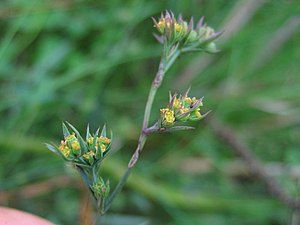Salt rabbit ear
| Salt rabbit ear | ||||||||||||
|---|---|---|---|---|---|---|---|---|---|---|---|---|

Salt rabbit's ear ( Bupleurum tenuissimum ) |
||||||||||||
| Systematics | ||||||||||||
|
||||||||||||
| Scientific name | ||||||||||||
| Bupleurum tenuissimum | ||||||||||||
| L. |
The salt rabbit's ear ( Bupleurum tenuissimum ) is an annual representative of the umbelliferae family (Apiaceae), which grows preferentially in salt-influenced areas.
Distribution and location
The salt rabbit's ear occurs from Central Europe to the Middle East mostly near the coast. Its distribution area includes the countries Morocco, Algeria, Tunisia, Spain, Portugal, France, Belgium, the Netherlands, Great Britain, Germany, Denmark, Sweden, Italy, Austria, the Balearic Islands, Corsica, Sardinia, Sicily, Slovenia, Croatia, Bosnia-Herzegovina , Montenegro, Albania, Serbia, Greece, Macedonia, Bulgaria, Hungary, the Czech Republic, Poland, Estonia, Slovakia, Romania, Ukraine, European Turkey, Russia, the Caucasus, Azerbaijan,; oldavia, Lebanon and the Sinai Peninsula. It grows preferentially on alternating damp, gappy salt marshes and in salt-influenced ruderal areas . It can also be found on the edges of weakly saline trenches. This type of plant tolerates calcareous soils.
It has its main occurrence in salt plant corridors. It has its main occurrence in plant communities of the Saginion maritimae association (beach fattening herb fields). Furthermore, it is the characteristic of the association Agropyro (Elymo) -Rumicion (cinquefoil-couch grass).
Identifying features
The salt rabbit's ear is a small, only 10 to 40 cm tall, more or less upright plant that flowers between August and September. In the external appearance ( habitus ) it appears delicate and often branched several times. It forms bluish green, entire-margined leaves that are linear to narrowly lanceolate in shape. The very small individual flowers form an umbel with a maximum of three rays. The three to five bracts are longer than the shortest umbel rays. The petals are yellowish to orange in color. The split fruit is only about 2 mm in size and appears grainy and rough on the outside. It contains short-lived seeds.
The chromosome number of the species is 2n = 16.
Hazard and protection
In Germany it is on the Red List of Endangered Vascular Plants and is classified there as "Highly Endangered". There are only stocks in the federal states of Schleswig-Holstein, Lower Saxony, Rhineland-Palatinate, Mecklenburg-Western Pomerania, Saxony-Anhalt and Thuringia. It is also endangered throughout Central Europe. However, it does not enjoy any separate legal protection. The main reasons for the decline in populations are the intensification of the use of extensive grassland (drainage, fertilization, conversion to arable land), the fallowing of fresh and wet meadows and the destruction of small-scale special locations.
literature
- Eckehart J. Jäger, Klaus Werner (Ed.): Excursion flora from Germany . Founded by Werner Rothmaler. 10th edited edition. tape 4 : Vascular Plants: Critical Volume . Elsevier, Spektrum Akademischer Verlag, Munich / Heidelberg 2005, ISBN 3-8274-1496-2 .
- Henning Haeupler, Thomas Muer: picture atlas of the fern and flowering plants of Germany . Ed .: Federal Agency for Nature Conservation (= The fern and flowering plants of Germany . Volume 2 ). Eugen Ulmer, Stuttgart (Hohenheim) 2000, ISBN 3-8001-3364-4 .
- Summary of species information at Flora Web.
Individual evidence
- ^ R. Hand (2011): Apiaceae. - In: Euro + Med Plantbase - the information resource for Euro-Mediterranean plant diversity. Data sheet Bupleurum
- ↑ a b c Erich Oberdorfer : Plant-sociological excursion flora for Germany and neighboring areas . With the collaboration of Angelika Schwabe and Theo Müller. 8th, heavily revised and expanded edition. Eugen Ulmer, Stuttgart (Hohenheim) 2001, ISBN 3-8001-3131-5 , pp. 706 .
Web links
- Salt rabbit ear. In: FloraWeb.de.
- Profile and distribution map for Bavaria . In: Botanical Information Hub of Bavaria .
- Salt rabbit ear . In: BiolFlor, the database of biological-ecological characteristics of the flora of Germany.
- Distribution in the Netherlands [1] (Dutch)
- Distribution worldwide
- Rabbit ear data sheet and pictures at Blumen in Swabia
